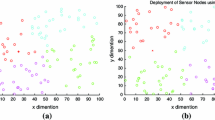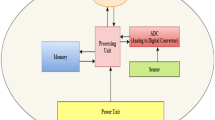Abstract
The current issues in the wireless sensor networks (WSN) are to enhance the efficiency of sensor nodes and their strength to handle node failure. This paper introduced an energy enhancement algorithm for clustering based on the properties of the fuzzy c-means. A novel algorithm is proposed using a fuzzy membership function and the Euclidean distance known as Fuzzk. The membership value of each node is calculated by the certainty that the highest value is considered as high if maximum sensor nodes situated closer to the head of the cluster. The proposed algorithm performed better to select the fusion center or cluster head as a base station of the network, so that energy consumption can be reduced as compared to the existing algorithm. The simulation results show that the energy consumption is reduced in our proposed Fuzzk algorithm that the same as LEACH, DEEC, and K-MEANS.
Access this chapter
Tax calculation will be finalised at checkout
Purchases are for personal use only
Similar content being viewed by others
References
Mehra P, Doja M, Alam B (2019a) Stability Enhancement in LEACH (SE-LEACH) for Homogeneous WSN. EAI Endorsed Trans. Scalable Inf. Syst. 6(20):156592
Mehra PS, Doja MN, Alam B (2019b) Enhanced Clustering Algorithm based on Fuzzy Logic (E-CAFL) for WSN. Scalable Comput. Pract. Exp. 20(1):41–54
B.Chen, H. Yao, M.Yang, B.J. LI, L.C. He, A Inter-Cluster Multi-Hop Routing Protocol Improved Based on LEACH Protocol, Chinese Journal of Sensors &Actuators 27(3) (2014).
Jain, Abhilasha, and Ashok Kumar Goel. “Energy Efficient Algorithm for Wireless Sensor Network using Fuzzy C-Means Clustering.” International (IJACSA) International Journal of Advanced Computer Science and Applications (2018).
Yadav, Rama Shankar, Arvind Kumar, and Smriti Agrawal. “Energy management for energy harvesting real time system with dynamic voltage scaling.” In Trends in Network and Communications, pp. 536–548. Springer, Berlin, Heidelberg, 2011.
Shreya Patel, Jayesh Munjani and Jemish Maisuria “A review of fuzzy related clustering protocol” International Journal of Computer Application (2250–1797) Volume 5– No. 3, April 2015.
Su S, Zhao S (2018) An optimal clustering mechanism based on Fuzzy-C means for wireless sensor networks. Sustainable Computing: Informatics and Systems 18:127–134
Kumar A, Alam B (2018) Task Scheduling in Real Time Systems with Energy Harvesting and Energy Minimization. J. Comput. Sci. 14:1126–1133
Sakkari, Deepak S., and T. G. Basavaraju. “Extensive Study on Coverage and Network Lifetime Issues in Wireless Sensor Network.” International Journal of Computer Applications 52, no. 8 (2012).
Kumar, Arvind, and Bashir Alam. “Real time scheduling algorithm for fault tolerant and energy minimization.” 2014 International Conference on Issues and Challenges in Intelligent Computing Techniques (ICICT). IEEE, 2014.
E.PRABASHINI, D.SIVAKUMAR “Energy Efficient Cluster-based Routing in WirelessSensor Networks” IJCSNS International Journal of Computer Science and Network Security, VOL.16 No.3, March 2016.
W. Heinzelman, A. Chadrakasan and H.Balakrishnan, “Energy-efficient communicationprotocol for wireless microsensor networks”, in Proceedings of the 33rd Annual HawaiIIInternational Conference on System Sciences, Jan 4–7, 2000.
Kumar, Arvind, and Bashir Alam. “Improved EDF algorithm for fault tolerance with energy minimization.” 2015 IEEE International Conference on Computational Intelligence & Communication Technology. IEEE, 2015.
Sharma Y, Dagur A, Chaturvedi R (2019) Automated bug reporting system with keyword-driven framework. Singapore, Soft Computing and Signal Processing. Springer, pp 271–277
Mehra PS, Doja MN, Alam B (2018) Stable Period Enhancement for Zonal (SPEZ)-Based Clustering in Heterogeneous WSN. In: Innovation S (ed) Systems and Technologies, vol 79. Singapore, Springer, pp 887–896
Author information
Authors and Affiliations
Corresponding author
Editor information
Editors and Affiliations
Rights and permissions
Copyright information
© 2021 The Author(s), under exclusive license to Springer Nature Singapore Pte Ltd.
About this paper
Cite this paper
Dagur, A., Malik, N., Tyagi, P., Verma, R., Sharma, R., Chaturvedi, R. (2021). Energy Enhancement of WSN Using Fuzzy C-Means Clustering Algorithm. In: Jeena Jacob, I., Kolandapalayam Shanmugam, S., Piramuthu, S., Falkowski-Gilski, P. (eds) Data Intelligence and Cognitive Informatics. Algorithms for Intelligent Systems. Springer, Singapore. https://doi.org/10.1007/978-981-15-8530-2_24
Download citation
DOI: https://doi.org/10.1007/978-981-15-8530-2_24
Published:
Publisher Name: Springer, Singapore
Print ISBN: 978-981-15-8529-6
Online ISBN: 978-981-15-8530-2
eBook Packages: Intelligent Technologies and RoboticsIntelligent Technologies and Robotics (R0)




